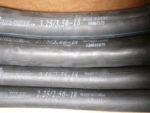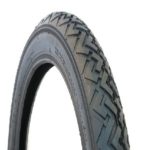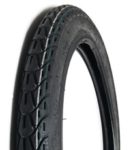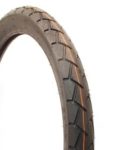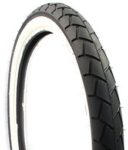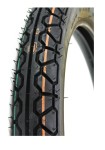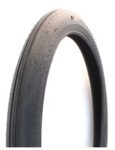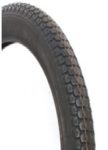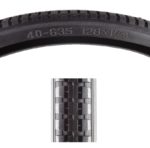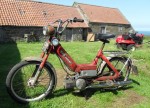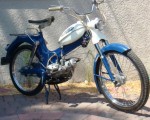Contents:
1. Tubes
2. Tubes Info
3. Tires
4. Tires and Rims Info
5. Dual Meaning of Tire Size
1. Tubes
All have straight metal valve stem type TR4, with two nuts.
One nut goes inside the rim, one goes outside.
2.50/2.75 – 12 fits 2.25 to 2.50 – 12
$6 9.5 oz (270 g) Sedona
.
.
2.00/2.25 – 14 fits 2.00 to 2.25 – 14
$8 7.0 oz (196 g) Kenda
.
.
2.25/2.50 – 14 fits 2.00 to 2.25 – 14
$10 10 oz (280 g) Sedona
.
.
2.25/2.50 – 16 fits 2.00 to 2.25 – 16
$10.0 8.0 oz (224 g) Sedona
N/A 10.5 oz (294 g) IRC
N/A 15.1 oz (430 g) Bikemaster
A wider Sedona tube is a heavy duty substitute.
Here a 2.75/3.00-16 tube fits in a 2.25-16 tire.
63% more weight for just 22% more price.
More care is required during installation.
The big benefit is a lot less flat tires.
2.75/3.00 – 16 fits 2.50 to 2.75 – 16
$12.0 13.1 oz (367 g) Sedonna
N/A 18.7 oz (530 g) Bikemaster
.
3.25/3.50 – 16 fits 3.00 to 3.50-16
$10 23.0 oz (650 g) Bikemaster
heavy duty
.
2.25/2.50 – 17 fits 2.00 to 2.25 – 17
$11.0 10.0 oz (280 g) Sedona
.
.
 70 / 100 – 17 fits 2.50 to 3.00 – 17
70 / 100 – 17 fits 2.50 to 3.00 – 17
$13 15.5 oz (444 g) Michelin
.
2.75/3.00 – 17 fits 2.50 to 2.75 – 17
$13.0 15.5 oz (444 g) Sedonna
2.25/2.50 – 18 fits 2.25 to 2.50 – 18
$13 12.4 oz (350 g) Sedona
(same tube as 2.50/2.75-18)
.
2.50/2.75 – 18 fits 2.25 to 2.50 – 18
$13 12.4oz (350 g) Sedona
(same tube as 2.25/2.50-18)
.
2.75/3.00 – 18 fits 2.50 to 3.00 – 18
$14 17.0 oz (480 g) Sedona
(same tube as 3.25/3.50-18)
.
3.25/3.50 – 18 fits 2.50 to 3.00 – 18
$14.0 17.0 oz (480 g) Sedona
(same tube as 2.75/3.00-18)
.
 2.25/2.50 – 19 fits 2.00 to 2.50 – 19
2.25/2.50 – 19 fits 2.00 to 2.50 – 19
$12.0 12 oz (340 g) Sedona
(same tube as 2.50/2.75-19)
.
 2.50/2.75 – 19 fits 2.25 to 2.50 – 19
2.50/2.75 – 19 fits 2.25 to 2.50 – 19
$13 12 oz (340 g) Sedona
(same tube as 2.25/2.50-19)
.
2. Tubes Info
Here are two actual sizes, labeled as four.
Upper 2 say 3.25/3.50-18 and 2.75/3.00-18.
Lower 2 say 2.50/2.75-18 and 2.25/2.50-18.
This is label dishonesty.
Expansion: One tube size can fit a range of tire sizes, because the rubber can stretch. The tube gets bigger as it is inflated with air, until it presses against the inside of the tire.
Correct Size Criteria: When a tube is the correct size for a tire, and it is inflated slightly (but not expanded), it should fit inside the tire. It should not need to expand out to contact the tire. When a tube is too thin, it has to expand, which makes it more vulnerable to punctures. When a tube is too wide, it has to be wrinkled or folded to fit inside a thin tire. Where the folds are at can lead to punctures caused by internal rubbing.
Label Dishonesty: There are some tubes with misleading labels. Like with food, you think you’re getting more than what is actually there. Comparing the weight is the best way to know how much rubber you’re getting. The bicycle industry does the same thing. The label says a bigger size than the tube really is. That uses less rubber, saving the manufacturer money. But the tube has to stretch more when inflated, so the wall thickness is less, which causes it to get punctured easier. Because of this mislabeling, some are recommended for a different width tire than what the box label says. Always compare weights when shopping for tubes, not just “size” and price!
3. Tires
14-1 tire 2.25 – 14
Kenda K261
22514VL171
classic street, price: $29
wt 3.2 lb, for rim 356 mm = 14″
14-2 tire 2.25 – 14
Vee Rubber 020
22514TL162
classic street, price: N/A
wt 2.9 lb, for rim 356 mm = 14″
15-1 tire 2.50 – 15
Shinko SR241
25016WP122
classic trail, price: N/A
wt 5.5? lbs, for rim 381 mm = 15″
16-1 tire 2.00 – 16 (20 x 2.0)
Vee Rubber 087
20016TL102
classic street, price: $42
wt 2.6 lb, for rim 406 mm = 16″
16-2 tire 2.25 – 16 (20 x 2.0)
Sava/Mitas B8
22516TL154
white wall, price: $65
wt 3.0 lb, for rim 406 mm = 16″
16-3 tire 2.25 – 16 (20 x 2.25)
Shinko SR714
22516WP152
modern street, price: $40.0
wt 4.0 lb, for rim 406 mm = 16″
16-4 tire 2.25 – 16 (20 x 2.25)
Sava B8
22516TL182
classic street, price: $42
wt 3.0 lb, for rim 406 mm = 16″
16-6 tire 2.50 – 16
Sava MC2
25016TL182
modern street, price: $44
wt 4.4 lb, for rim 406 mm = 16″
16-7 tire 2.50 – 16
Vee Rubber 219
25016VL152
classic trail, price: $30
wt 4.3 lb, for rim 406 mm = 16″
16-9 tire 2.50 – 16
Sava B8
25016TL162
classic street, price: $42.0
wt 3.2 lb, for rim 406 mm = 16″
16-10 tire 2.75 – 16
Mitas MC2
27516TL123
modern street, price: $49
wt 4.4 lb, for rim 406 mm = 16″
16-11 tire 3.00 – 16
Shinko SR244
30016WP132
modern trail, price: $32 on sale
wt 6.3 lb, for rim 406 mm = 16″
16-13 tire 90/80 – 16
Shinko SR714 = 3.25 – 16
908016WP172 3.5″ wide
modern street, price: $29 on sale
wt 6.5 lb, for rim 406 mm = 16″
16-14 tire 3.25 – 16
Mitas MC2
32516TL183 3.6″ wide
modern street, price: N/A
wt 6.0 lbs, for rim 406 mm = 16″
17-1 tire 2.00 – 17 (21 x 2.0)
Vee Rubber 126
20017TL112
classic street, price: $35.0
wt 3.5 lb, for rim 432 mm = 17″
17-2 tire 2.00 – 17 (21 x 2.0)
IRC NR58 110mph S-rated
20017TL102
classic street, price: $36.0
wt 2.9 lb, for rim 432 mm = 17″
17-3 tire 2.00 – 17 (21 x 2.25)
Mitas MC11
20017TL122
modern street, price: none
wt 2.8 lb, for rim 432 mm = 17″
 17-4 tire 2.25 – 17 (21 x 2.25)
17-4 tire 2.25 – 17 (21 x 2.25)
Kenda K261
22517VL181
classic street, price: $34.0
wt 4.4 lb, for rim 432 mm = 17″
17-5 tire 2.25 – 17 (21 x 2.25)
Mitas/Sava B4
22517TL152
classic street, price: $39.0
wt 3.2 lb, for rim 432 mm = 17″
17-6 tire 2.25 – 17 (21 x 2.25)
Shinko SR704
22517WP152
classic street, price: $39.0
wt 3.3 lb
17-7 tire 2.25 – 17 (21 x 2.25)
Mitas MC11
22517TL162
modern street, price: none
wt 3.6 lb, for rim 432 mm = 17″
17-9 tire 2.25 – 17 (21 x 2.25)
Mitas MC11 white
22517TL193
white wall, price: N/A
wt 3.6 lb, for rim 432 mm = 17″
17-10 tire 2.25 – 17 (21 x 2.25)
Mitas/Sava B4
22517TL193
white wall, price: $56
wt 3.2 lb, for rim 432 mm = 17″
17-12 tire 2.50 – 17
Mitas/Sava MC11
25017TL182 2.7″ wide
modern street $42.0
wt 4.6 lb, for rim 432 mm = 17″
17-13 tire 2.50 – 17
Mitas M-06
25017TL142
modern street, price: none
wt 4.8 lb, for rim 432 mm = 17″
17-14 tire 2.50 – 17
Mitas/Sava B4
25017TL182
classic street, price: $44.0
wt 4.0 lb, for rim 432 mm = 17″
17-15 tire 2.50 – 17
Mitas MC11 white
25017TL144
modern street, price: none
wt 3.6 lb, for rim 432 mm = 17″
17-16 tire 2.50 – 17
Vee Rubber 021
25017VL182
classic trail, price: $27.0
on sale wt 4.4 lb, rim 432 = 17″
17-17 tire 2.50 – 17
Shinko SR244
25017WP112
modern trail, price: $31
wt 4.9 lb, for rim 432 mm = 17″
17-19 tire 2.75 – 17
Mitas/Sava MC11
27517VL142
modern street, price: $39
wt 5.1 lb, for rim 432 mm = 17″
17-20 tire 2.75 – 17
IRC TR1 Trial
27517TR182
classic trail, price: $41
wt 5.1 lb, for rim 432 mm = 17″
17-21 tire 3.00 – 17
IRC NR21
30017TR113
street tire, price: N/A
wt 4.8 lb, for rim 432 mm = 17″
18-1 tire 2.25 – 18 (22 x 2.25)
Mitas B4
22518TL172
classic street, price: $46.0
wt 3.9 lb, for rim 457 mm = 18″
18-3 tire 2.50 – 18
Mitas/Sava B3
25018TL172
classic street, price: $46
wt 4.0 lb, for rim 457 mm = 18″
18-5 tire 2.50 – 18
IRC NR2
25018TR122
classic street, price: N/A
wt 4.6 lb, for rim 457 mm = 18″
18-7 tire 2.75 – 18
Sava MC7
27518TL192
modern street, price: $49
wt 5.8 lb, for rim 457 mm = 18″
18-9 tire 3.00 – 18
Sava MC7
30018TL192
modern street, price: $53
wt 6.0 lb, for rim 457 mm = 18″
19-1 tire 1.75 – 19 (23 x 2.0)
Hutchinson 21B
17519TL182 2.0″ wide
friction drive flat top, price: $46.0
wt 2.0 lb, for rim 483 mm = 19″
19-2 tire 2.00 – 19 (23 x 2.0)
Mitas M02
20019TL712
classic street, price: $36.0
wt 2.2 lb, for rim 483 mm = 19″
19-3 tire 2.25 – 19 (23 x 2.25)
Mitas M02
22519TL832
classic street, price: $40.0
wt 2.4 lb, for rim 483 mm = 19″
19-4 tire 2.25 – 19 (23 x 2.25)
Vee Rubber 013
22519TL542
classic street, price: none
wt 4.5 lb, for rim 483 mm = 19″
stiff sidewalls
19-5 tire 2.25 – 19 (23 x 2.25)
Heidenau M3
22519TL082
classic street, price: $42.0
wt 3.5 lb, for rim 483 mm = 19″
20-1 tire 2.00 – 20 (24 x 2.0)
Kenda Kwick Drumlin Cargo
20020JB000 heavy duty
4-ply 75 psi bicycle tire, price: N/A
wt 2.5 lb, for rim 507 mm = 20″
for 1952 Motobecane, and others
20.5-1 tire 1.85 – 20.5 (24 x 1¾ S7)
Sunlite S7 for vintage Schwinn
185205JB000 light duty
2-ply 50 psi bicycle tire, price: N/A
wt 1.3 lb, for rim 520 mm = 20.5″
for 1958 Parilla, and others
21-1 tire 2.50 – 21
Shinko SR413
25021TL123
classic trail, price: N/A
wt lb, for rim 533 mm = 21″
for 1985 Derbi RD50, others
22-1 tire 2.00 – 22 (26 x 2.0)
Kenda Kwick Drumlin Cargo
20022JB000 heavy duty
4-ply 75 psi bicycle tire, price: N/A
wt 2.7 lb, for rim 559 mm = 22″
for 1955 Lambretta, others
23-1 tire 1.50 – 23 (26 x 1½ = 650B)
Schwalbe Road Cruiser
15023JB000 1.46″ wide
85 psi bicycle tire, price: N/A
wt 1.6? lb, for rim 584 mm = 23″
for 1949 Solex, others
25-1 tire 1.50 – 25 (28 x 1½ = 700B)
Sunlite UtiliT Street Classic
15025JB000 1.57″ wide
50 psi bicycle tire, price: N/A
wt 1.6 lb, for rim 635 mm = 25″
for 1940 Solex, others
4. Tire and Rim Info
Motorcycle tires are for 8, 9, 10, 12, 13, 14, 15, 16, 17, 18, 19, 21 and 23 inch rims. See below.
Bicycle tires are for 12(16×2), 13.2(18), 16(20×2), 18 (22×2), 20(24×2), 22(26×2) inch rims.
History: Before the 1970’s motorcycle and bicycle tires were the same. Some time in the late 1960’s, as safety standards improved, motorcycle and bicycle tires were separated. Bicycle tires were given even rim sizes, while motorcycle tires were given mostly odd rim sizes. Motorcycle tires for USA motor vehicles had to comply with DOT safety standards, with speed and weight ratings. Bicycle tires had different safety standards.
Correct size: The insides of the tire must match the outer sides of the rim, where the tire seats at. If the tire fits too loose it will work for low pressure only. At normal or high pressure the loose tire would tend to bulge out, allowing the tube to escape. Then the tube balloons out quickly and pops. If the tire fits too tight, a section of the tire will not stretch over the outer side of the rim. This happens when the center rim band is too wide or when tape is placed over the rim outer sides. In either case the tire will not seat correctly. One or both sides will have a flat section, instead of a perfect circle. That causes a bumpy ride on perfectly smooth streets, less grip and control.
Correct installation: The inner tube must be completely inside the tire, not pinched between the tire and rim. It often gets pinched near the valve stem, if the stem is not pushed way inward before tire mounting. That makes the tire fit too tight, causing the above problems, plus the pinched section will become chaffed (worn), leading to a flat tire later on.
14 inch rim (356 mm)
Fourteen inch rims are pretty much only on mopeds and junior off road bikes.
This 1981 Honda NC50 Express
has 14″ rims.
Tires say “2.25 – 14”
15 inch rim (381 mm)
Wide tires for 15 inch rims are common on modern street motorcycles, like “130/90 -15” (5 inch wide) to “170/80 – 15” (6 1/2 inch wide), but thin 15’s are uncommon. Size “2.50 – 15” (2 1/2 inch wide) is pretty much only found on 1970’s small trail bikes by Yamaha, Kawasaki, and others. No bicycles have that 381mm rim size. So there’s only this one choice.
This 1973 Yamaha GT1 (80cc)
has 15″ rims,
with “2.50 – 15” trail tires.
16 inch rim (406 mm)
Tires for sixteen inch rims are on about 1/3 of all USA mopeds, while 17″ is the other 2/3. Almost all Italian mopeds use 16″ rims, with mostly 2.25 – 16 (20.5″ OD) tires. Juvenile and BMX bicycles all use 16 inch rims, but they are called 20″ in the bicycle industry. Yes, 20 x 2.125 bicycle tires interchange with 2.25 – 16 motorcycle tires, because they both use 406mm rims. Motorcycle tires for on-road use have to meet US DOT standards, and have many things labeled on the tire. Bicycle tires have different safety standards, and are not legal and not safe to use on on-road motorcycles.
This 1980 Tomos Bullet
has 16″ rims.
Tires said “20×2.25″ and “2.25–16″
17 inch rim (432 mm)
This 1969 Puch Maxi has 17″ rims.
Original ’60’s tires said “21 x 2.0”
’70’s also said “2.00 -17”
Notice 17 = 21 – 2*2.0
18 inch rim (456 mm)
Some 1960’s tires were labeled narrower than modern tires. The Harley Davidson M65 original tires said 22 x 1 3/4 (1.75 – 18), but they were actually 2.00 or 2.25 in width. You can see the restored M65 rear tire is thinner than the rim. Yet in old photos the tires are wider than the rims. A 2.25-18 motorcycle tire is a better choice than a 22 x 1.75 bicycle tire.
Left, a 22 x 1.75 bicycle tire
on a 1967 Harley Davidson M65
This 1969-72 Tomos Colibri 14V has 18″ rims
with “23 x 2.5″ tires
Notice 18 = 23 – 2*2.5
Pre-69 had 19” rims. with “23 x 2.25” tires
This 1962 Motobecane AV48 had 19″ or 18″ rims
with “23 x 2.0” or “22-1/2 x 2-1/4” tires.
Notice 19 = 23 – 2*2
and 18 = 22.5-2*2.25
19 inch rim (484 mm)
Many vintage motorized bicycles had 19 inch rims, with (now obsolete) bicycle tires size 23 x 2.0 (equal to 2.0 – 19 or French 550 x 50B). By the 1970’s, tires were smaller and wider, 16 and 17 inch. Of the US model mopeds, only the Solex had 19″ rims. 19 inch tires thinner than 2.75 are not sold by normal USA motorcycle or bicycle tire suppliers. The thinnest “metric street” tire available is 80/90 – 19, which is about 2.75 – 19.
This 1956 Sparta
FP50 has 19″ rims,
with “23 x 2.0” tires
This 1963 Sears Allstate
has 19″ rims. Original
tires said “23 x 2.25”
1962 Tomos Colibri
T12 has 19″ rims,
with “23 x 2.25” tires.
This 1966 Solex 3800
has 19″ rims.
Tires say 1.75-19 but they’re
actually 2 inch wide, 2.00-19
This 2000 Solex 3800,
an Impex remake, has 19″ rims
with 1.75-19 tires.
20 inch rim (507 mm)
Some vintage motorized bicycles had 20 inch rims, that accept bicycle size 24 x 2.125 “balloon” tires. For them, fat bicycle tires, for a mini beach cruiser, are an affordable option. Street classic tread all black is shown, but other choices exist. Whitewall 24 x 2.125 available also. Most bicycle shops carry 24×2.125 tires also. The ISO number on every bicycle tire is what tells the rim size. This tire says 57-507, which means 57mm wide (2.24″) and 507mm (20.0″) inner diameter.
This 1955 Sparta
FP50 has 20″ rims,
with “24 x 2.0” tires
This 1952 Motobecane
AV32 has 20″ rims.
Orig tires say “600x50B
Michelin 24 x 1-1/2 x 2”
Notice 20 = 24 – 2*2.0
20.5 inch rim (520 mm)
Here are all tire sizes near 20.5” rim:
(ISO 483 = 19.0″) 2.25 – 19 motorcycle
(ISO 507 = 20.0″) 24 x 2.0 bicycle
(ISO 520 = 20.5“) 24 x 1¾ S7 for old Schwinn
(ISO 533 = 21.0”) 2.50 – 21 motorcycle
21 inch rim (534 mm)
Twenty one is a common front rim size on off road and street cruiser motorcycles. The thinnest street tire is 80/90-21, which equals 2.75-21. The thinnest off road commonly available is also 2.75 – 21. Vintage French bicycles had 21″ rims with “600B” or “24 x 1-1/2” tires, but not modern bicycles.
Any rim can be measured to determine the bead diameter, where the tire sits. One way is to wrap a cloth measuring tape around the tire-less rim to measure the circumference, then divide by 3.14. See Sheldon Brown Rim Measuring for more details.
This 1985 Derbi RD50
has a 21″ front rim,
with a “2.50 – 21” tire
22 inch rim (559 mm)
Some vintage motorized bicycles had 22 inch rims, that accept bicycle size 26 x 2.125 “balloon” tires. For them, wide bicycle tires, for a beach cruiser or mountain bike, are an affordable option. Street classic tread all black is shown, but other choices exist. Whitewall 26 x 2.125 available also. Most bicycle shops carry 26×2.125 tires also. The ISO number on every bicycle tire is what tells the rim size. This tire says 57-559, which means 57mm wide (2.24″) and 559mm (22.0″) inner diameter. For more about tire sizes see Sheldon Brown Tyre Sizing. Bicycle tires are intended for low speed and low weight. They have no motor vehicle safety endorsements, like “street-legal” or “DOT” tires do. They are listed here to show what all the choices are. But they are not recomended for use on motor vehicles.
This 1955 Lambretta
has 22″ rims that take
26×2.125 bicycle tires.
Originals said “22×2.0”
Notice 22 = 26 – 2*2.0
23 inch rim (584 mm)
Twenty three inch rims are on antique motorcycles, and on some off road front, and also some on road front customs for novelty. Modern downhill mountain bike racers use 23 inch rims, called “27.5 x 2.0”. 1950’s French bicycles use 23″ rims, called “650B” or “26 x 1-1/2”. Some modern commuter bikes also use 650B tires (584mm rim), in-between a mountain bike 26″ (559mm) and road bike 700C (622mm). Antique motorcycles from the 1910’s, 20’s, 30’s use the bicycle system, where the tire size means the outer diameter. So, at least some 28 x 2.5 tires correspond to 2.50 – 23, but maybe not all. A 28 x 2.5 or 28 x 3.0 antique replica tire costs around $200 and up from Coker Tire. Measure the rim diameter precisely to determine the rim size, on any vintage, antique, or unknown motorcycle. A 23-inch-rim tire costs ten times as much as a 22-inch-rim tire!
This 1954 Mercier has
23″ rims with 650B tires.
650 is the outer diameter.
B is the width, 33mm.
Note 584 = 650 – 2*33
This 1949 Solex has
23″ rims with “650B”
or “26 x 1-1/2” tires.
Notice 23 = 26 – 2*1.5
24 inch rim (610 mm)
For some reason, there are no bicycles or motorcycles, except for some antique ones possibly, with 24″ rims. If there were any antique motorcycles with “28 x 2.0” or “29 x 2.5″ tires, they likely had 24” rims. Most early motorcycle tires were “28 x 2.5″, assumed to be a 23” rim, or “28 x 3.0″, assumed to be a 22” rim.
25 inch rim (635 mm)
Twenty five inch rims are not on any motorcycle. They are on older traditional bicycles, still common “work horse” bicycles in Europe and Asia, today. In less developed places in the world, the 28 x 1-1/2 tires, rod brake (not cables), always black, classics out number all other vehicles. The “700B” French size tire had a height of 32 or 33mm, to make an outer diameter of 700mm.
This 1940 Solex has
25″ rims, with “700B”
or “28 x 1-1/2” tires.
Notice 25 = 28 – 2*1.5
As you go back in time, tires were bigger and thinner, just like with automobiles!
5. Dual Meaning of Tire Size
The “size” of the tire has a different meaning for bicycles, than for motorcycles and cars. For bicycles, the tire size means the outer diameter of the tire. For motorcycles and cars, the tire size means rim size, which is the inner diameter of the tire. So a 20 x 2.125 bicycle tire fits a 16″ moped rim. Conversely, a 2.25 – 16 moped tire fits a 20″ bicycle rim.
Vintage motorcycle tires: After about 1969, motorcycle tires no longer used the bicycle system. From then on, “22 x 2.0” meant bicycle 18 inch rim, and “2.0 – 18” meant motorcycle 18 inch rim. Bicycles were given the even numbered rim sizes 16, 20, 22 while motorcycles were given the odd numbered rim sizes 17, 19, 21, 23, pretty much. Bicycles were given the “outer times width” syntax “22 x 2.0”, while motorcycles given the “width dash rim” syntax “2.0 – 18”. The “x” and the “-” are not interchangeable. Also the order is not interchangeable. This was a new way to tell the difference between a bicycle tire and a motorcycle tire, just by the “tire size”.
Rim measurement: You can measure any rim with a tape measure, and determine the tire size. Try to measure the rim diameter at the “porch”, where the tire sits, not the “lip” at the very edge. A 16″ rim will have a total diameter of 16.6″. So don’t count the lip. This method settles the confusion of whether a marking or specification is using the bicycle (tire OD) or motorcycle (tire ID) system. Older mopeds often have 2.25-18 (22 x 2.25) and 2.25-19 (23 x 2.25) tires. They used the bicycle system. Modern moped-size (thin) tires, since the 1970’s, all use the motorcycle system, in the USA. Some modern electric scooters have an oddball size, 16 x 3.00. It’s a bicycle size, because a 16 x 2.25 bicycle tire fits, but wider. It’s a solid aluminum disk rear wheel, and so the inner tube valve stem must be the 90 degree type. The rim diameter at the “porch” is about 12″. A motorcycle inner tube size 3.00-12 fits perfect, but they are only available with straight valve stems. Tires and tubes for those must be purchased from the dealer or distributor of those electric scooters.














